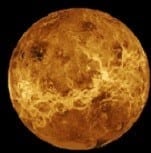UCF Professors Land NASA Grants Focused on Asteroids, Comets, Venus
 UCF professors are involved in two potential NASA spacecraft missions that could take flight as early as 2020.
UCF professors are involved in two potential NASA spacecraft missions that could take flight as early as 2020.
The five proposed space missions would study Venus, near-earth objects and a variety of asteroids and comets. Each mission team will receive $3 million and have a year to get their proposals ready for a final round of review. At that point two missions will be selected to fly as part of the NASA Discovery Mission program. The final two missions will get about $500 million in addition to launch funding.
UCF Physics Professor Dan Britt, Ph.D., is co-investigator of the Lucy project, which would perform the first reconnaissance mission of the Jupiter Trojan asteroids. This collection of asteroids is thought to hold vital clues to deciphering the history of the solar system. Harold Levison of the Southwest Research Institute in Boulder, Colo., is the principal investigator.
“This shows that UCF has become a serious player in NASA’s planetary exploration program,” Britt said. “I can’t wait to get started.”
Yan Fernandez, Ph.D., an associate professor of physics who specializes in comets and is the director of the UCF Robinson Observatory, echoed Britt’s excitement. He is a co-investigator of another selected project: the Near Earth Object Camera (NEOCam).
NEOCam would discover 10 times more near-earth objects than all NEOs discovered to date, according to NASA. It would also begin to characterize them. Amy Mainzer of NASA’s Jet Propulsion Laboratory in California is the principal investigator. Along the way, the project would also discover more comets and collect much more detailed data about comets already known to exist.
“This is so exciting,” Fernandez said. “To be involved with a mission that’s potentially answering such fundamental questions, and to be involved at this detailed level is thrilling,” he said.
The other projects are:
- Deep Atmosphere Venus Investigation of Noble gases, Chemistry, and Imaging (DAVINCI) led by Lori Glaze of NASA’s Goddard Space Flight Center in Maryland. DAVINCI would study the chemical composition of Venus’ atmosphere during a 63-minute descent. It would be designed to answer scientific questions that have been considered high priorities for many years, such as whether there are volcanoes active today on the surface of Venus and how the surface interacts with the atmosphere of the planet.
- The Venus Emissivity, Radio Science, InSAR, Topography, and Spectroscopy mission (VERITAS) led by Suzanne Smrekar of NASA’s Jet Propulsion Laboratory. VERITAS’ goal would be toproduce global, high-resolution topography and imaging of Venus’ surface and produce the first maps of deformation and global surface composition.
- Psyche led by Linda Elkins-Tanton of Arizona State University. Psyche would explore the origin of planetary cores by studying the metallic asteroid Psyche. This asteroid is likely the survivor of a violent hit-and-run with another object that stripped off the outer, rocky layers of a protoplanet.
Created in 1992, NASA’s Discovery Program sponsors frequent, cost-capped solar system exploration missions with highly focused scientific goals, according to NASA. The program has funded and developed 12 missions to date, including MESSENGER, Dawn, Stardust, Deep Impact, Genesis and GRAIL, and is currently completing development of InSight. The Planetary Missions Program Office at NASA’s Marshall Space Flight Center in Huntsville, Ala., manages the program for the agency’s Science Mission Directorate.
“The selected investigations have the potential to reveal much about the formation of our solar system and its dynamic processes,” said John Grunsfeld, astronaut and associate administrator for NASA’s Science Mission Directorate in Washington. “Dynamic and exciting missions like these hold promise to unravel the mysteries of our solar system and inspire future generations of explorers. It’s an incredible time for science, and NASA is leading the way.”
NASA’s Discovery Program requested proposals for spaceflight investigations in November 2014. A panel of NASA and other scientists and engineers reviewed 27 submissions.
For more information about NASA’s Discovery Program, visit: http://discovery.nasa.gov
To read the original stories click the links below.
http://today.ucf.edu/ucf-professors-land-nasa-grants-focused-on-asteroids-comets-venus/
http://phys.org/news/2015-10-nasa-future-key-planetary-mission.html
